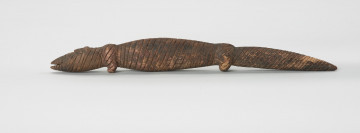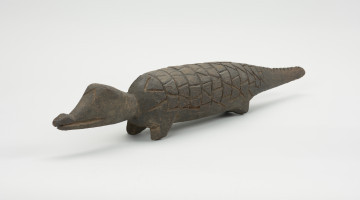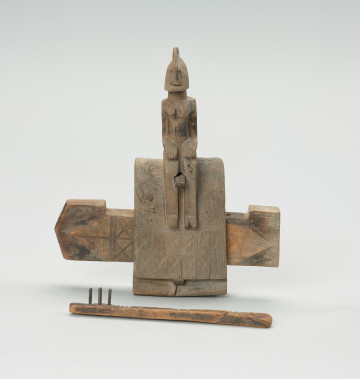
Zoomorphic figurine, figurine of crocodile
między 1951 — 2000
National Museum in Szczecin
Part of the collection: Collection of Dogonian art
The figurine depicts ayo geu - a short-toed crocodile (Osteolaemus tetraspis), which is the most popular caring animal of the Dogon next to the panther and the python. Some researchers believe that the cult of protective animals in the Dogon is a form of totemism.Guardian animals are treated with great respect. It is forbidden to hunt them, kill them or consume their meat. In the village of Amani, where the crocodile is the guardian animal, when someone comes across the remains of a dead reptile they give it the same funeral as a human. The Dogon believe that when an old man dies a natural death, after death he will transform himself into an animal that was a guardian animal for his family. The living can also transform into guardian animals, but this is quite risky. In the oral tradition, there are many stories of men who have done this, but then had enormous problems getting back into human form. Animals reciprocate for the special care they receive. They show themselves to their family members at important moments in their lives, settle near their homes, warn and protect them from danger. When a caring animal harms a person or their property, it is blamed on people who have not shown it enough respect. This is also the reason why many animal species are now extinct or absent in Dogon country. The crocodile is the only animal whose numbers have increased. This has been influenced by the development of tourism recorded at the turn of the 20th and 21st centuries. Crocodiles are relatively easy to observe and feeding them (usually poultry) has become one of the tourist attractions.The figurine was a part of a fortune-telling set.
Ewa Prądzyńska
Author / creator
Dimensions
cały obiekt: height: 4 cm, width: 2,5 cm
Object type
figure
Creation time / dating
Creation / finding place
Identification number
Location / status

między 1951 — 2000
National Museum in Szczecin

około 1960
National Museum in Szczecin

circa 1970
National Museum in Szczecin
DISCOVER this TOPIC
Castle Museum in Łańcut
DISCOVER this PATH
Educational path